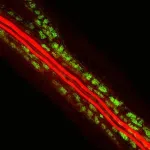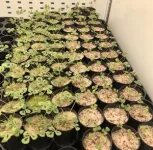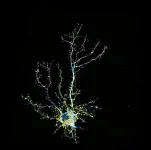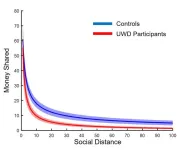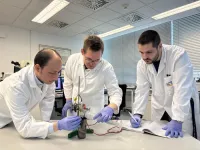(Press-News.org) LA JOLLA (April 18, 2025)—Industrial farming practices often deplete the soil of important nutrients and minerals, leaving farmers to rely on artificial fertilizers to support plant growth. In fact, fertilizer use has more than quadrupled since the 1960s, but this comes with serious consequences. Fertilizer production consumes massive amounts of energy, and its use pollutes the water, air, and land.
Plant biologists at the Salk Institute are proposing a new solution to help kick this unsustainable fertilizer habit.
In a new study, the researchers identified a key molecule produced by plant roots, a small peptide called CLE16, that encourages plants and beneficial soil fungi to interact with each other. They say boosting this symbiotic relationship, in which the fungi provide mineral nutrients to the plants through CLE16 supplementation, could be a more natural and sustainable way to encourage crop growth without the use of harmful artificial fertilizers.
The findings were published in The Proceedings of the National Academy of Sciences on April 18, 2025.
“Many plants evolved to engage in symbiotic relationships with other species, but industrial breeding techniques have dampened many symbiosis traits in our modern-day crops and cemented their dependence on chemical fertilizers,” says senior author Lena Mueller, an assistant professor at Salk. “By restoring the natural symbiosis between plant roots and fungi, we could help crops get the nutrients they need without the use of harmful fertilizers.”
In this mutually beneficial relationship, soil-borne arbuscular mycorrhizal fungi supply plants with water and phosphorous, which the plants accept in exchange for carbon molecules. These exchanges occur by specialized symbiotic fungal tendrils, called arbuscules, burying themselves into plant root cells. Around 80% of plants can trade resources with fungi in this way. However, the traits that support this symbiosis have been weakened over centuries of agricultural plant breeding that prioritized creating crops with the biggest yields.
Salk scientists say new crop varieties could be bred to strengthen these traits again—an opportunity they intend to explore through the Institute’s Harnessing Plants Initiative.
To begin discovering and strengthening these traits, Mueller’s lab started by growing a species of arbuscular mycorrhizal fungus together with Medicago truncatula, a small Mediterranean legume. Once the two had formed a symbiotic relationship, the researchers looked to see what genes were supporting this interaction.
The legumes had started to express large amounts of a small signaling molecule called CLE16—a member of the CLE family of peptides. These small signaling molecules are present in many plant species yet have been relatively understudied. Until CLE16, the only plant CLE peptides scientists had studied were working against symbiosis.
"We found the first plant CLE peptide to actually favor and promote symbiosis,” says first author Sagar Bashyal, a graduate student in Mueller’s lab. “It’s really exciting from a scientific perspective to get such a surprising new insight into these peptides. It’s a huge step toward achieving sustainable plant-fungi relationships in the field.”
To confirm that CLE16 was promoting the symbiotic relationship, Bashyal added excess CLE16 to the soil to see what would happen. The extra dose of CLE16 caused the fungal arbuscules to become more robust and live longer, ultimately increasing the abundance of these nutrient-trading structures in the roots. The result was a self-amplifying pro-symbiosis signal: The more the beneficial fungus expanded inside the roots, the more CLE16 was produced by the plant, which then promoted even more fungal colonization.
The team then did a series of experiments to understand how CLE16 was encouraging this interaction between plants and beneficial fungi. Their findings revealed that CLE16 promotes the symbiosis via the signaling protein CORYNE (CRN), a component of the CLAVATA receptor complex known for its roles in plant responses to the environment.
As a plant becomes stressed, it enters a heightened immune state to protect itself from any further threats. However, this also inadvertently makes the plant less receptive to surrounding fungi. Mueller predicts that when CLE16 binds to the CRN-CLAVATA receptor complex, this reduces the plants’ stress levels and immune reactivity, allowing the beneficial fungus to enter the plant roots and begin the nutrient exchange.
Importantly, Mueller’s team showed that many arbuscular mycorrhizal fungi also produce their own CLE16-like peptides, which also promoted symbiosis when added to the soil. The researchers think that these fungal peptides imitate the plants’ own CLE16 peptides, thus enabling the beneficial fungus to amplify symbiosis by binding to the same plant CRN-CLAVATA receptor complexes.
With validation that both plant CLE16 and fungal CLE16-like peptide supplementation improved symbiosis, a similar supplementation on farmland may be the solution to kick-starting the growth of fungal networks that benefit crops year after year.
Future work will validate whether CLE16 peptides or fungal CLE16-like peptide mimics also promote symbiosis in important crops, like soy, corn, or wheat. If they do, harnessing these molecules to replace unsustainable, polluting chemical fertilizers with beneficial fungi will begin.
“Beyond acting as a biological fertilizer, arbuscular mycorrhizal fungi also add a layer of natural protection to plants that could help us reduce pesticide use, too,” says Mueller. “If we can leverage beneficial fungi and other microbes to help plants establish these symbiotic relationships, we can make our crops, fields, and soils more sustainable and healthier in the long run.”
The work was supported by start-up funds from the University of Miami and the Hess Foundation, as well as the United States Department of Agriculture’s National Institute of Food and Agriculture (2022-67013-42820).
About the Salk Institute for Biological Studies
Unlocking the secrets of life itself is the driving force behind the Salk Institute. Our team of world-class, award-winning scientists pushes the boundaries of knowledge in areas such as neuroscience, cancer research, aging, immunobiology, plant biology, computational biology, and more. Founded by Jonas Salk, developer of the first safe and effective polio vaccine, the Institute is an independent, nonprofit research organization and architectural landmark: small by choice, intimate by nature, and fearless in the face of any challenge. Learn more at www.salk.edu.
END
Peptide imitation is the sincerest form of plant flattery
Salk scientists use small peptides to enhance symbiosis between plants and fungi, offering a sustainable alternative to artificial fertilizers
2025-04-14
ELSE PRESS RELEASES FROM THIS DATE:
Archaeologists discover historical link between inequality and sustainability
2025-04-14
EMBARGOED UNTIL 15.00 US ET (20.00 BST) ON MONDAY 14 APRIL 2025
The study lead by Professor Dan Lawrence, of Durham University in the UK, found that across ten millennia, more unequal distributions of wealth correlated with longer-term human settlement.
However, the team are keen to stress that one factor is not causally dependent on the other, giving hope that humankind’s survival is not linked to ever increasing inequality.
The research is part of a Special Feature of the Proceedings of the National Academy of Sciences (PNAS), entitled Global Dynamics of Wealth Inequality.
Sustainability is defined by the ...
Researchers develop an LSD analogue with potential for treating schizophrenia
2025-04-14
University of California, Davis researchers have developed a new, neuroplasticity-promoting drug closely related to LSD that harnesses the psychedelic’s therapeutic power with reduced hallucinogenic potential.
The research, published in Proceedings of the National Academy of Sciences, highlights the new drug’s potential as a treatment option for conditions like schizophrenia, where psychedelics are not prescribed for safety reasons. The compound also may be useful for treating other neuropsychiatric ...
How does our brain regulate generosity?
2025-04-14
Are there areas of the brain, which regulate prosocial, altruistic behaviour? Together with colleagues from the universities in Lausanne, Utrecht and Cape Town, researchers from Heinrich Heine University Düsseldorf (HHU) have studied a very special group of patients and established that the “basolateral amygdala” (part of the limbic system) plays an important role in this. In the scientific journal Proceedings of the National Academy of Sciences (PNAS), they describe that this region calibrates social behaviour.
Prosocial ...
New study reveals wealth inequality’s deep roots in human prehistory
2025-04-14
PULLMAN, Wash. — Wealth inequality began shaping human societies more than 10,000 years ago, long before the rise of ancient empires or the invention of writing.
That’s according to a new study led by Washington State University archaeologist Tim Kohler that challenges traditional views that disparities in wealth emerged suddenly with large civilizations like Egypt or Mesopotamia. The research is part of a special issue of the Proceedings of the National Academy of Sciences, co-edited by Kohler and Amy Bogaard, an archaeologist at Oxford University in England.
Drawing on data from over 47,000 residential ...
New archaeological database reveals links between housing and inequality in ancient world
2025-04-14
If the archaeological record has been correctly interpreted, stone alignments in Tanzania’s Olduvai Gorge are remnants of shelters built 1.7 million years ago by Homo habilis, an extinct species representing one of the earliest branches of humanity’s family tree.
Archaeological evidence that is unambiguously housing dates to more than 20,000 years ago—a time when large swaths of North America, Europe and Asia were covered in ice and humans had only recently begun living in settlements.
Between that time and the dawn of industrialization, the archaeological record is rich not only with evidence of settled life represented by housing, but also with evidence ...
New, non-toxic synthesis method for “miracle material” MXene
2025-04-14
It is one of the most significant trends in materials science: materials that consist of only a single layer of atoms, so-called “2D materials”, often show completely different properties than thicker layers consisting of the same atoms. This field of research began with the Nobel Prize-winning material graphene. Now, research is being conducted into the material class of MXenes (pronounced Maxenes), which consist mainly of titanium and carbon, by TU Wien (Vienna) together with the companies CEST and AC2T.
These MXenes have properties that ...
Cutting-edge optical genome mapping technology shows promise for diagnosis, prognosis, and therapeutic options of multiple myeloma
2025-04-14
Philadelphia, April 14, 2025 – Researchers have demonstrated the potential of the innovative optical genome mapping (OGM) technique for the diagnosis, prognosis, and therapeutic management of multiple myeloma. This new study in The Journal of Molecular Diagnostics, published by Elsevier, details how this novel method can establish the cytogenomic profile of the tumor on a scale suitable for routine practice in cytogenetics laboratories.
Multiple myeloma, a type of blood cancer that forms in plasma cells (a type of white blood cells), is the second ...
Study looks at impact of COVID-19 pandemic on rates of congenital heart disease procedures among children
2025-04-14
Major reallocation of healthcare services during the COVID-19 pandemic meant that elective surgery in children with congenital heart disease (CHD) was significantly reduced, so that those needing urgent, lifesaving and emergency surgery could be treated. However, this prioritisation of the most severely ill children did not increase overall post-operative complications rates or death, a study led by the University of Bristol has shown.
The research, published in Open Heart, suggests that prioritising surgery for younger and more critically ill children may be appropriate when there is a sudden disruption of usual care. The ...
UH researcher unveils new model to evaluate impact of extreme events and natural hazards
2025-04-14
When you’re on a sandy beach or the banks of a river, transformed by rolling waves or slightly still waters, it’s likely you’re not thinking about what happens just beneath the surface, where dirt and pollution are swirling and traveling through to new destinations.
But Hanadi Rifai does. The Moores Professor of Civil and Environmental Engineering and director of the Hurricane Resilience Research Institute, has spent two decades examining Galveston Bay – its tides, currents ...
Illegal poisonings imperil European raptors and could disrupt ecosystem health
2025-04-14
A recent comprehensive assessment on the poisoning of raptors across Europe does not yield good news. This is according to the new paper “Poisoning in Europe Between 1996 and 2016: A Continental Assessment of the Most Affected Species and the Most Used Poisons,” published in the Journal of Raptor Research. A large team of raptor researchers amassed retrospective data on poisoning events across 22 European countries between 1996 and 2016. Carbofuran and aldicarb were the most common toxins reported and disproportionately affected scavenging raptors, especially in Northern ...
LAST 30 PRESS RELEASES:
Study finds most people trust doctors more than AI but see its potential for cancer diagnosis
School reopening during COVID-19 pandemic associated with improvement in children’s mental health
Research alert: Old molecules show promise for fighting resistant strains of COVID-19 virus
Journal of Nuclear Medicine Technology supplement highlights advances in theranostics and opportunities for growth
New paper rocks earthquake science with a clever computational trick
ASH 2025: Milder chemo works for rare, aggressive lymphoma
Olfaction written in bones: New insights into the evolution of the sense of smell in mammals
Engineering simulations rewrite the timeline of the evolution of hearing in mammals
New research links health impacts related to 'forever chemicals' to billions in economic losses
Unified EEG imaging improves mapping for epilepsy surgery
$80 million in donations propels UCI MIND toward world-class center focused on dementia
Illinois research uncovers harvest and nutrient strategies to boost bioenergy profits
How did Bronze Age plague spread? A sheep might solve the mystery
Mental health professionals urged to do their own evaluations of AI-based tools
Insufficient sleep associated with decreased life expectancy
Intellicule receives NIH grant to develop biomolecular modeling software
Mount Sinai study finds childhood leukemia aggressiveness depends on timing of genetic mutation
RSS Research Award for new lidar technology for cloud research
Novel AI technique able to distinguish between progressive brain tumours and radiation necrosis, York University study finds
Why are abstinent smokers more sensitive to pain?
Alexander Khalessi, MD, MBA, appointed Chief Innovation Officer
Optical chip pioneers physical-layer public-key encryption with partial coherence
How your brain understands language may be more like AI than we ever imagined
Missed signals: Virginia’s septic strategies overlook critical timing, study warns
Delayed toxicities after CAR T cell therapy for multiple myeloma are connected and potentially preventable
Scientists find cellular key to helping plants survive in saltwater
Medical cannabis program reduces opioid use
Immunotherapy works for sepsis thanks to smart patient selection
Cardiovascular events 1 year after RSV infection in adults
US medical prices and health insurance premiums, 1999-2024
[Press-News.org] Peptide imitation is the sincerest form of plant flatterySalk scientists use small peptides to enhance symbiosis between plants and fungi, offering a sustainable alternative to artificial fertilizers

